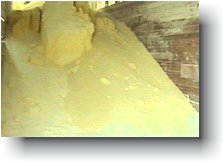| Georgia Gulf Sulfur Corporation |
| s | Sulfur Properties
Sulfur is an odorless, tasteless, light yellow solid. It is a reactive element that given favorable circumstances combines with all other elements except gases, gold, and platinum. Sulfur appears in a number of different allotropic modifications: rhombic, monoclinic, polymeric, and others. The rhombic structure is the most commonly found sulfur form. Each allotropic form differs in solubility, specific gravity, crystalline, crystalline arrangement, and other physical constants. These various allotropes also can exist together in equilibrium in definite proportions, depending on temperature and pressure. Rhombic And Monoclinic Sulfur Both the rhombic and monoclinic crystalline modifications of sulfur are made up of eight sulfur atoms arranged in a puckered-ring structure. At one atmosphere pressure and temperatures less than 95.4șC, rhombic is the stable crystalline form. Above 95.4șC to the melt temperature of 118.9șC, the monoclinic crystalline structure is dominant. Rhombic and monoclinic sulfur are soluble to a limited extent in most organic solvents. A high degree of solubility is attained in carbon disulfide which is often used to dissolve rhombic sulfur for analysis. Sulfur is not readily wetted or dissolved by water. Similarly, rhombic and monoclinic sulfur have limited solubility in natural rubber and synthetic elastomers at room temperatures. In most cases, the use level of sulfur in different elastomers exceeds the solubility level of sulfur in that elastomer. Polymeric Sulfur At 160șC and higher, the eight-member-ring sulfur molecule is energized and ruptures. The open-chain sulfur molecule that takes shape combines to make long unbranched polymer chains by a free radical mechanism. At high temperatures, crystalline patterns are established by the polymer as the long chains frequently orient into a coiled helix similar in bond angle to the eight-member ring. The polymeric allotrope of sulfur is insoluble in organic media, natural and synthetic rubber as well as in carbon disulfide. Because of this insolubility, polymeric sulfur is referred to as insoluble sulfur. Chemical Name: Sulfur
|
| Home
Page | Products | Safety Info | Sulfur Facts
| Affiliates | Site
Map | Contact Us |
Copyright © 2000 Georgia Gulf Sulfur Corporation |
